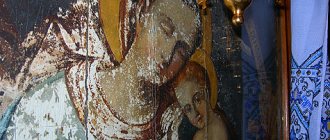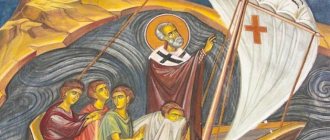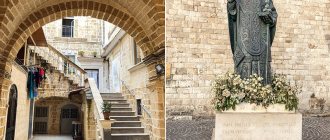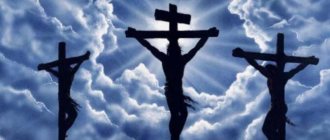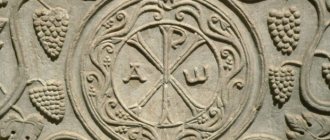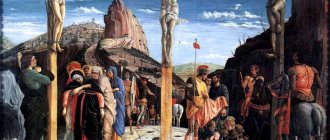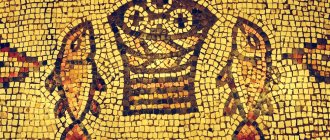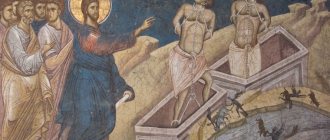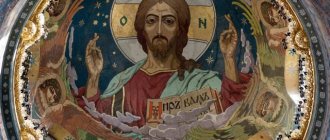Transferred images
Nikolai Ge in the film “What is Truth” conveyed the image of Pontius Pilate, who is responsible for order and preservation of the existing structure of society. Christ as a prophet prevented the current government from maintaining dominant influence, and also influenced the minds of people, forcing them to think about moral principles, good and evil, life and death. Pontius Pilate holds his head proudly, trying to reproach Christ, to explain to him that the image of the preacher is false and ridiculous. His interlocutor listens attentively to the procurator, without interrupting his monologue. Christ and Pilate do not find out what the truth is, since the first interlocutor knows this, and the second, dressed in a mantle and endowed with authority, is afraid to hear the truth.
The image of Jesus in the painting has some peculiarities. Since the Renaissance, people have become accustomed to seeing him as a physically tall man, with a refined face and exquisite features. The plot presents a slightly different image to the audience. Christ is strict, modest, exhausted. There is a legend that a relative of Ge, looking at the painting “What is Truth,” reproached the artist for depicting an ugly image: Christ has blackened eyes, disheveled hair, and a gloomy look. The remark of a loved one outraged the great master. He replied that a person is beautiful not by external, but by internal virtues. First of all, he must be smart, modest, kind, reasonable. Only the combination of good manners and generosity, sacrifice reveals a great personality in him, but not the beauty of his body or face.
Let's return to Pontius Pilate. His image in the picture screams of wealth and influence. What are his clothes, the arrogant expression on his face, and his proud posture worth? Ge in his image concentrated not only the vices of society of that time, but also an inquisitive mind that tried to unravel the mystery of Christ. Of course, no one at that time had the courage to call himself a prophet and son of God. Pilate tried to understand Christ, as well as his feelings towards this Jew, who was generous without wealth, without love he was fully gifted with it.
Nikolai Ge - What is truth? (history of the painting)
Nikolai Nikolaevich Ge is an outstanding Russian Itinerant artist. His technique of executing paintings based on gospel subjects was innovative for his time and largely misunderstood by his contemporaries. Many of them faced a difficult fate: they were prohibited from being shown at exhibitions of the Itinerant artists; his non-classical Christ was too expressive and unrecognizable. After the artist’s death, the fate of several of his most interesting paintings cannot be traced.
That’s how one of his paintings, “Mercy,” disappeared. He showed it for the first and last time in 1880 at the VIII exhibition of the Itinerants. A photograph remained of her, which was published in an album of the artist’s works in 1903. The painting depicts two figures: a girl giving water to a beggar. She looks after him, asking herself the question “Isn’t this Christ?” Ge's son Pyotr Nikolaevich and his daughter-in-law Ekaterina Ivanovna Zabelo posed for the artist to paint the images of this painting. This canvas visibly represents the words of the Sermon on the Mount: “Blessed are the merciful, for they will obtain mercy” (Matthew 5:7). Ge presented his own interpretation of the gospel story, which was not at all welcomed by critics. The painting remained misunderstood, was subjected to unjustifiably harsh judgments, and the artist himself was dissatisfied with it. He took it to his workshop, and only 10 years later it was completely recorded with a new painting, “What is Truth?” . An interesting fact is that Pavel Mikhailovich Tretyakov liked the painting; he did not purchase the painting, but from his letters to L.N. Tolstoy. it is clear that he considered it successful.
In history, a number of masters painted on already used canvases, so Ge N.N. is not an exceptional artist in this regard. There could be several reasons for this: one of them is that Nikolai Nikolaevich lived quite modestly and, moreover, at a distance from large cities; he did not always have a blank canvas at hand. But I want to believe in another version: his idealistic consciousness crucified itself for failed plans, he did not spare his works, cut them, peeled off the paint layer, and wrote them down with new subjects. This happened with “Mercy” - the painting “What is truth?” was painted on top of it. (Christ and Pilate) in 1890, the history of which is replete with interesting facts.
This picture of Ge became the most controversial in his biography. It was painted on the plot of the 18th chapter of the Gospel of John (as evidenced by the author’s signature on the picture): the moment is depicted when Christ says: “I... came into the world for this purpose, to testify to the truth...”, and Pilate disdainfully answers him "What is truth?" Pontius Pilate does not want to listen to him anymore; the teachings of Christ are insignificant for him. He - the Roman ruler of Judea, the governor of Lucius Licinius Lucullus, a friend of Roman bohemia - considers the noise raised around this puny man to be just a mouse fuss. The figure of Pilate is outlined in light, it is grandiose, powerful, self-confident. Having said these words, he turns around and leaves, Christ following him with his eyes. This thin man was beaten all night, they spat in his face, they mocked him, he prayed that he would be spared his suffering. Before Pilate he no longer has physicality; in the picture he is shrouded in shadow. But the expression in his eyes suggests that he loves this man, mired in lies. If Christ came to this world to preach about the truth, then he must tell Pilate about his teaching.
Ge N.N. showed this painting at a traveling exhibition in 1890. Everyone approved of the composition, color and light in the painting, but the image of Christ caused many criticisms. The public was divided into two camps: the first were those who considered the painting to offend religious feelings, the second were those who had been looking for such realism in paintings on religious themes all their lives. And indeed, the picture turned out to be very true. The artist understood that paintings depicting Christ could not be historical, because for his time Christ was an invisible figure, and the image of the Teacher in a benevolent form at the end of the 19th century was no longer relevant. This picture gave rise to so many opposing opinions because it found and touched on a plot that was important for Christ at that very moment in his life, but it was depicted non-canonically. It was difficult for critics, confined within a dogmatic framework, to accept the disheveled, painful image of the Savior. We can say that Ge’s painting “What is Truth?” became a kind of milestone in Russian painting.
The painting was bought by P.M. Tretyakov. in 1890 at the insistence of Lev Nikolaevich Tolstoy, who foresaw that it would become a real pearl in the gallery’s collection. But the picture was not immediately included in the exhibition. It is known that lawyer Ilyin N.D., who was a follower of Tolstoy’s teachings, persuaded Nikolai Nikolaevich to allow him to show this work abroad: he hoped that there it would cause the same stirring of minds as in Russia. The film was a success in Germany, especially among working people: it visited Hamburg, Berlin, and Hanover. Then she went to America - Baltimore and Boston - but, unfortunately, the public there remained completely indifferent to her, even despite the patronage of Leo Tolstoy, who loved this picture very much. Ilyin had a hard time in America, he did not have enough money to advertise exhibitions, accommodation, he asked the artist himself, Tolstoy and even Tretyakov for money. Returning to Russia, he wrote the book “The Diary of a Tolstoyan”, where he spoke about N.N. Ge in an unflattering manner. and the writer, but these reviews remained unanswered: like a true Tolstoyan, Ge forgave him for these groundless insults.
The painting is still in the collection of the Tretyakov Gallery. Over time, it became covered with small cracks, the coverage of the paints decreased, and the outline of the head began to appear through the top paint layer. Specialists from the Tretyakov Gallery took 35 x-ray photographs from the surface of the painting, combining all the images, they discovered the “disappeared” painting by N.N. Ge. “Mercy” (“Isn’t this Christ?”). During the study of the underlying layers, one interesting detail became clear: before the painting “What is Truth?” the artist tried variations of his “Crucifixion” - on the right side of the canvas one can discern the contours of a cross and a crowd of people. According to the testimony of his son, “Mercy” already in the mid-1880s. went to correspondence, the artist was completely disappointed in this picture. In the final version, the girl was remade into the figure of Christ.
And yet it is a pity that the painting “Mercy” has not been preserved. It could become one of the few examples of the embodiment of the symbolic and realistic gospel interpretation of mercy: as long as mercy is alive in the hearts of people, Christianity will also be alive.
Below is an x-ray of the painting "Mercy".
Do you want your home to be transformed beyond recognition? For you, canvas prints from Decor Interior. Paintings and photographs on canvas in the interior are a new word in the art of design.
The purpose of truth is transformation.
“For I rejoiced exceedingly when the brethren came and testified of your faithfulness, how you walk in the truth. There is no greater joy for me than to hear that my children walk in the truth.” 3 John 3-4.
There is no greater blessing than walking in the truth. This means that we must recognize the truth, condemn what it points to, hate what is sin, and then, by the power of the Spirit, bring sin to death. Thus we will be in continuous development, in continuous sanctification, and in a continuous process of being transformed into the image of Jesus.
It is possible for each of us to walk in the truth, which can free us from sin, from its consequences and from its power over us. (John 8:32) God loves each of us and His riches are sufficient for everyone who calls on Him. The Holy Spirit - the Spirit of truth will help us in this continuous process of liberation. The faster we recognize the truth, the faster this process will move.
To what result will love for truth lead us? We will no longer be who we were by nature, but the life of Jesus will be revealed in us.
“But we all, with open face, beholding as in a mirror the glory of the Lord, are being transformed into the same image from glory to glory, even as by the Spirit of the Lord.” 2 Corinth. 3:18.
When we judge ourselves, and by faith put to death what the truth shows us about ourselves. By faith we are transformed into the image of His glory.
Read more: Why transformation is the most glorious of God's promises.
Truth in literature and art
“Anyone who sincerely wants the truth is already terribly strong.”
F.M. Dostoevsky
Thinking about this writer’s thought, we understand that it is not as simple as it might seem. What immediately comes to mind is: who doesn’t want her? It is unlikely that such a person exists in the world. After all, this is simply the same as what it really is, a true picture of the world around us. And who doesn’t want to see the world exactly as the Lord created it?
Here the next question arises: why want this at all? After all, a person dreams of what he does not have. It turns out that we do not have a true picture of the world? But besides this, we don’t want us to have it, except for those who want it, about whom Fyodor Mikhailovich tells us.
When discussing this concept, I also recall the novel by M.A. Bulgakov "The Master and Margarita". For the first time this word appears in the novel in the phrase “temple of truth,” which Yeshua promises to erect on the ruins of the old faith. Thus, truth is a sacred concept, sublime, erecting and creating temples. If we want to know what it is, we must ascend spiritually and from there see our life and our path. M.A. tells us about this. Bulgakov, and his characters reveal them in the novel.
Let us also remember the ancient saying from the Indian Rajas, taken by H.P. Blavatsky as a motto:
“There is no religion higher than truth.”
After all, she does not come to us in formal clothes, she is modest, she looks ordinary, but often this happens because we do not pay attention to her.
I would like to pay special attention to the work of N.A. Berdyaev “The Truth of Orthodoxy”, in which he tries to understand what this concept means for the Orthodox Church. “I am the way, the truth and the life.” This means that this concept must be understood holistically, it is existential. Truth is not given to a person in a ready-made form; it can only be acquired through path and life. It involves movement to infinity. The part is taken for the whole, preventing the feeling of completeness. This is precisely why Jesus did not answer Pontius Pilate’s question about the truth. He is the truth himself, but one that needs to be unraveled throughout history. It is primary, not secondary, that is, it is a discrepancy with something else. And, finally, in the last instance, she is God, our heavenly king, who, in turn, is the truth, says Berdyaev.
Truth is not the correspondence to reality, but its meaning. A spiritual awakening to truth must occur in a person, otherwise it is not achieved, because this is a creative discovery, this is a creative transformation of reality. It is complete even when it refers to a part.
It is completely wrong to say that only that which is obligatory is true. It can be revealed only to one and denied by the rest of the world, it can be prophetic, but the prophet is always alone. According to N.A. Berdyaev, the concept that interests us is not an objective, existential reality reflected in the knower and included in him, but enlightenment, the transformation of reality, the introduction into the world of a quality that was not in it before its knowledge and revelation.
